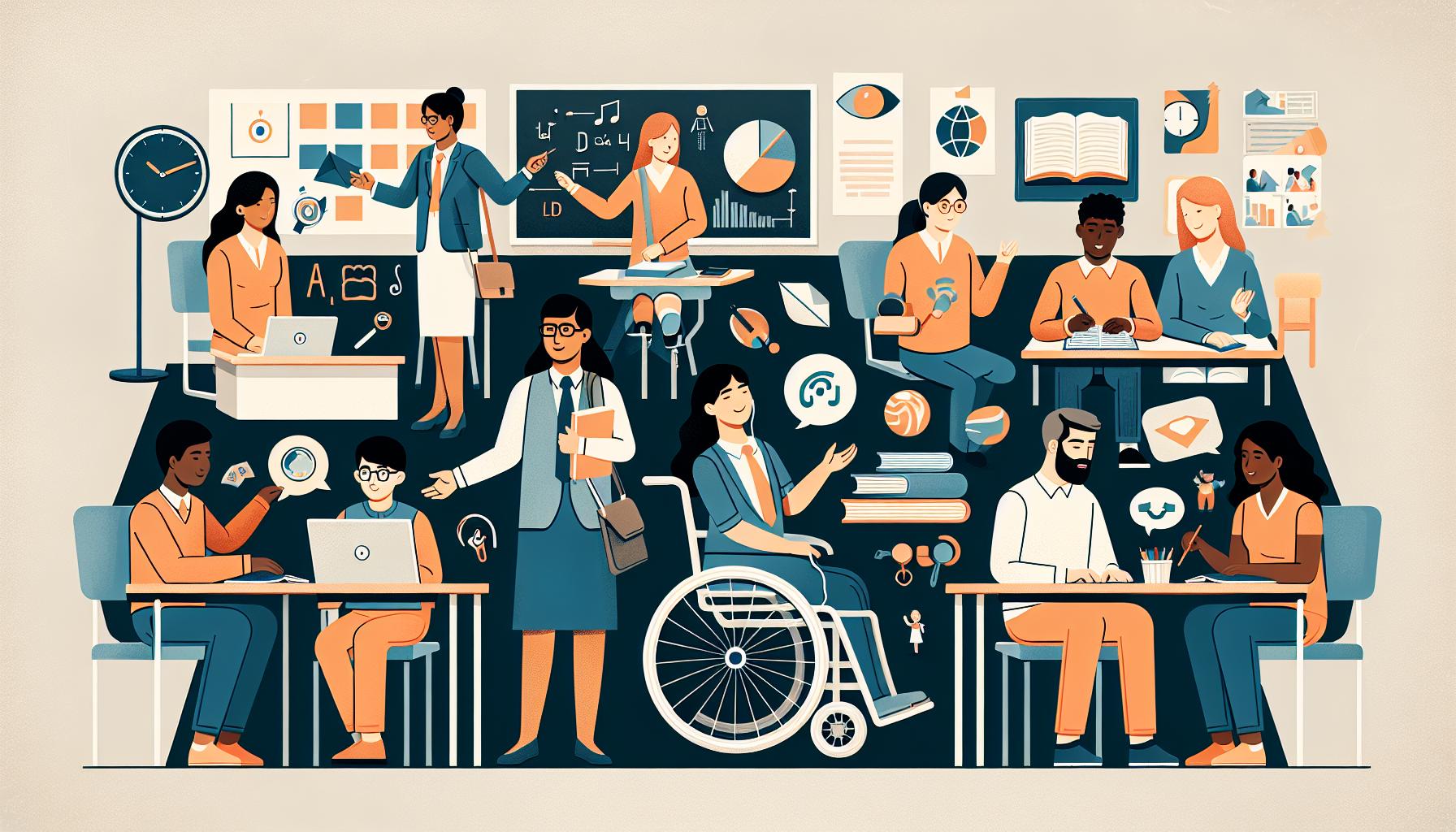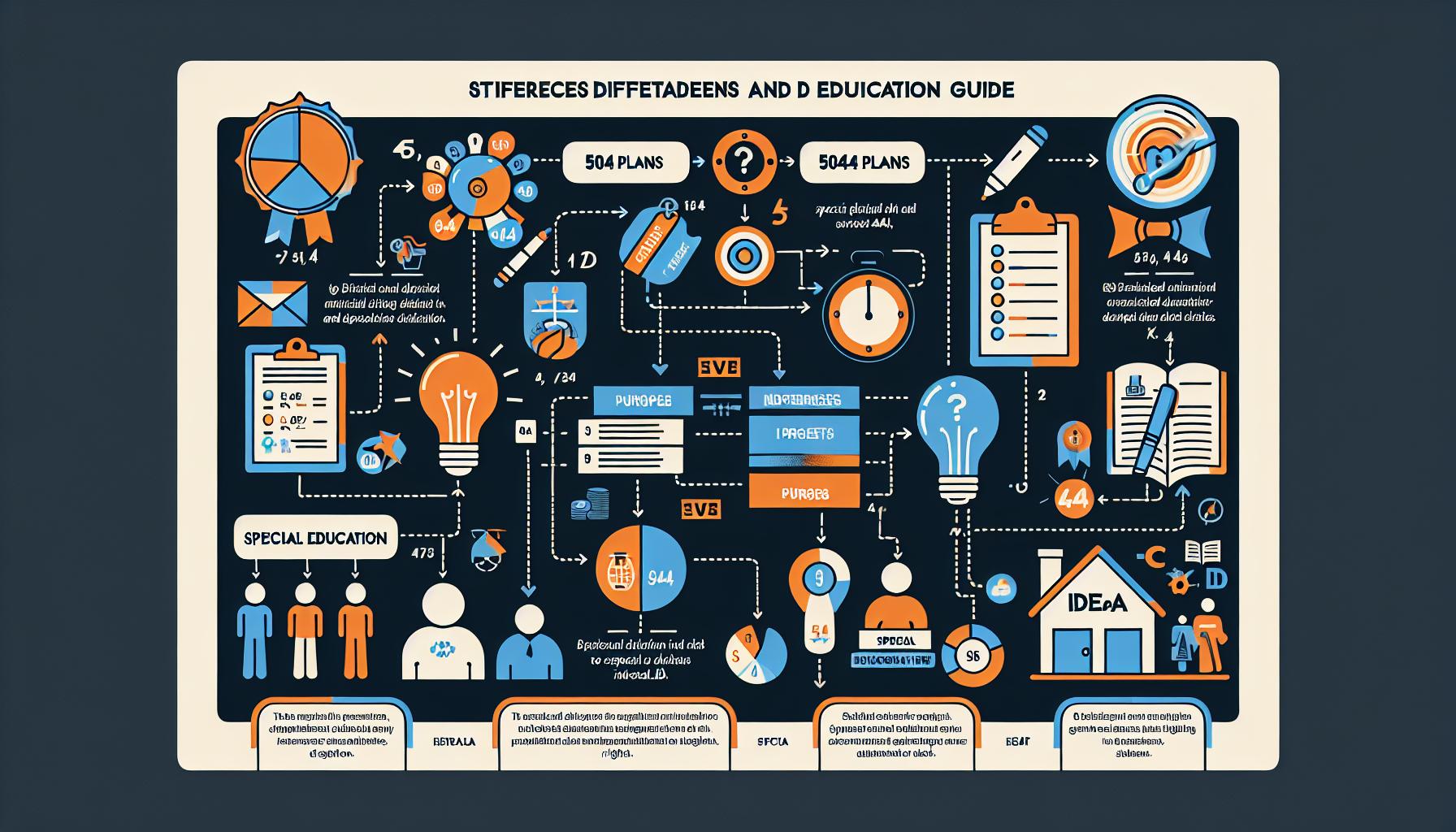Understanding the Role of a 504 Plan in Special Education: Inclusivity for All Students
You’ve probably heard the term “504 plan” tossed around in educational circles, but what does it really mean? Is it part of special education or something else? Let’s clear up the confusion.
A 504 plan, named after Section 504 of the Rehabilitation Act of 1973, is a legal document designed to level the playing field for students with disabilities. It’s not quite special education, but it does ensure that students with disabilities have the same access to education as their peers.
Understanding the ins and outs of a 504 plan can be tricky. But don’t worry, we’re here to guide you through it. From its origins to its implementation, we’ll make sure you’re well-versed in what a 504 plan entails. With the right knowledge, you can ensure that every student gets the education they deserve.
Key Takeaways
- A 504 plan, stemming from Section 504 of the Rehabilitation Act of 1973, is a legal document that aims to provide equal educational opportunities for students with disabilities. It mainly addresses access-related barriers rather than customizing the curriculum, differing from Special Education.
- Eligibility for a 504 plan includes any student whose impairment significantly limits a major life activity, such as learning, speaking, reading, etc. It’s flexible, personalized, and does not necessarily equate to requiring Special Education.
- A crucial distinction lies in the relationship between a 504 plan and Special Education. While both aim at educational equality, Special Education mandates specialized instruction for students with certain disabilities, following an Individualized Education Program (IEP). Conversely, a 504 plan focuses on removing access-related physical and academic barriers in the regular classroom setting.
- Understanding the legal foundation of 504 plans is essential. As part of the Rehabilitation Act of 1973, Section 504 is implemented in all federally funded programs or activities, to eliminate discrimination against individuals with disabilities.
- The implementation of a 504 plan involves identifying a student’s disability, designing appropriate educational accommodations, and continuous monitoring and constant adjustments to ensure effective learning. Communication is critical among parents, students, and teachers for the successful execution of a 504 plan.
- With a 504 plan, the aim is not only academic success but also total participation in non-academic and extracurricular activities. Necessary adjustments should be regularly reassessed and modified to ensure an inclusive and accessible community, promoting a sense of belonging for all students.
What is a 504 Plan?

In a context heavily filled with legal jargon 504 plan may seem like an elusive concept. Let’s have a closer look to demystify what it really stands for. A 504 plan falls under Section 504 of the Rehabilitation Act of 1973, standing as a legal safeguard to ensure equal educational opportunities for students with disabilities.
You might think, ‘What makes it different from special education?’ It’s a valid question indeed. Unlike Special Education, which customizes the curriculum to fit the child’s specific needs, a 504 plan primarily addresses access-related barriers. Its goal is to make sure students with disabilities can learn alongside their peers in a standard classroom environment.
A 504 plan can be seen as a set of accommodations needed to assist students with disabilities be fully integrated into the school culture and curriculum. This might incorporate modifications in test scheduling, homework deadlines, seating arrangements, or even assistive technology, to name just a few examples.
So, who’s eligible for a 504 plan? The answer underscores the broad ranging impact of Section 504. Any student with an impairment that significantly limits a major life activity – be it learning, speaking, reading, writing or performing math calculations – would be considered under the 504 umbrella. However, keep in mind this eligibility is not equivalent to requiring Special Education.
Understanding a 504 plan helps draw the line between distinctive but intersecting circles of special education and disability rights. If there’s an area of grey, it’s likely where these circles overlap and the 504 plan becomes an indispensable tool.
Remember, the specifics of a 504 plan hinge on the unique needs of each student – because of this flexibility, it’s important to actively participate in making suitable accommodations for the concerned student. Gaining a solid grasp on the 504 plan details significantly shines a light on the path towards equal education for all.
Hence, let’s continue to the next section where we’ll discuss more about how a 504 plan is implemented…
Relationship Between 504 Plan and Special Education

Diving further into the 504 plan, it’s crucial to understand its relationship with special education. While they may seem quite similar at first glance, ample differences exist between the two.
Special Education, defined under the Individuals with Disabilities Education Act (IDEA), differs from a 504 plan in critical ways. It’s designed specifically for students who have certain listed disabilities and require specialized instruction beyond what is normally provided in general education. This special instruction is encompassed within an Individualized Education Program (IEP).
A 504 plan, on the other hand, doesn’t necessitate specialized instruction. It calls for removing access-related barriers in the regular classroom setting. These could be purely physical barriers, like providing wheelchair ramps, or academic, such as extended test-taking times. What’s essential is the student continues with the standard curriculum alongside their peers.
Imagine both the 504 plan and special education as two different means to a similar end – ensuring equal educational opportunities for students with disabilities. What you need to remember is that they offer separate legal rights and provide varying levels of support.
Here’s a quick comparison of the two:
| 504 Plan | Special Education | |
|---|---|---|
| Purpose | Removing access-related barriers | Specialized instruction |
| Legal Right | Section 504 of the Rehabilitation Act | Individuals with Disabilities Education Act |
| Requirement | Student has impairments significantly limiting major life activities | Student has a listed disability and requires special instruction |
An essential aspect of a 504 plan is flexibility, it adapts according to each student’s needs. So, in contrast to special education that has firm categories, the 504 plan presents a more tailored solution. Selecting the right plan is crucial for each student, and understanding these key differences will guide you in making that decision. Regular participation and expert advice are indispensable to ensure the most suitable accommodations are being made.
As mentioned earlier, a 504 plan is not the same as special education, but it is definitely a stride towards achieving a comprehensive educational environment for everyone. It emphasizes the importance of tailored accommodations for each student with a focus on eliminating barriers rather than deducing unique teaching strategies.
Legal Foundation of a 504 Plan

Diving deeper into the intricate layers of the education system, you’ll encounter the legal basis of a 504 plan. Born from the Rehabilitation Act of 1973, specifically Section 504, this act is a civil rights law designed to eliminate discrimination against individuals with disabilities. It’s applied in any program or activity receiving Federal financial assistance – obviously, including public schools.
Section 504 stipulates accessibility for students with disabilities – a principle key to understanding 504 plans. It represents an assurance to remove barriers in a standard education setting and provide equal educational opportunities. Your student’s journey is not about special education but about ensuring meaningful participation in the general education curriculum.
You will notice a shared goal between a 504 plan and the Individuals with Disabilities Education Act (IDEA). Both aim to level the playing field, ensuring education equity for all students – those with disabilities and without. Yet, while IDEA demands specialized instruction, a 504 plan steps in when the student’s disability doesn’t necessarily need special education services, but does need adaptations or accommodations within the general education program.
Here’s a blow-by-blow comparison:
| IDEA | 504 Plan |
|---|---|
| Specialized instruction | General Education Accommodations |
| Specific learning disability requirement | Broader disability definition |
| Federal funding available | No specific federal funding |
So, while IDEA and 504 plans are companions in the journey to educational equity, remember they’re distinctly different tools. One provides special education, the other ensures accessibility. It’s like comparing a ramp for wheelchair access to a building (504 plan) with a specialized course adapting instruction methods (IDEA).
Knowledge of the legal foundation of 504 plans empowers parents and educators, allowing you to advocate effectively for your students and creating an inclusive, harmonious education environment. Understanding these nuances will make way to ensure that students with varying needs get the best possible opportunities.
Implementation of a 504 Plan
Crafting an effective 504 plan initiates with the identification of a disability that disturbs a student’s learning. If you’re an educator, ensure the chosen evaluative method doesn’t discriminate against the student due to their impairment. Remember, the evaluation should measure the student’s aptitude or achievement level and not the disability’s extent.
Once the disability’s clearly defined, professionals, such as teachers, psychologists or therapists, must collaborate to formulate the appropriate accommodations for the student. These range from modified equipment, additional time on tests, and preferential seating, among others. The keyword here is “individualized” as the accommodations must cater to the student’s specific needs. Your role, whether you’re a parent or an educator, is crucial in continuously monitoring and adjusting these accommodations to ensure they’re aiding the student’s academic progress effectively.
Importantly, the 504 plan encapsulates more than academic accommodations. It’s also designed to ensure the student’s full participation in non-academic and extracurricular activities. You’ll need to guarantee that these aspects of your student’s school life, like lunch, recess, clubs or sports, aren’t affected negatively by their disability.
Implementing a 504 plan also implies frequent reassessments. Schools should conduct formal reviews annually. Still, continuously observe and document the student’s progress and barriers to their learning. This process helps guarantee that the plan remains current, catering to changing academic needs and challenges.
Parents and educators must thoroughly understand the 504 plan’s execution. A well-constructed 504 plan has the power to bridge the gap between disability and learning, fostering a school environment where all students can thrive. Communication is the cornerstone of a successful 504 plan. Teachers, parents, and students should dialogue regularly, keeping feedback loops open. This continuous communication empowers every student to succeed, diffusing potential barriers created by their disabilities.
Ensuring Equal Access to Education
Seeking academic success should never be hindered by disability. By implementing a 504 plan, you’re helping to level the playing field for students with disabilities. It’s not just about meeting legal obligations – promoting inclusive education brings multiple benefits to your school community at large.
Equal access to education often begins with simple accommodations. Adjusting seating arrangements, allowing extra time on tests, adding auditory cues – these are all valid strategies. However, remember it’s your duty to continue reassessing and adapting these accommodations. Your student’s needs may change over time and each learning environment can present new challenges. That’s why it’s important to maintain open lines of communication with everyone involved: parents, students, and other educators.
Your 504 plan isn’t just about academic support either. It’s about making sure that students can fully participate in all aspects of a school community. If there’s a field trip, for example, necessary adjustments should be made to ensure the student can attend and engage alongside their peers. Just as academics thrive in an inclusive setting, so too do extracurricular and non-academic activities.
Let’s consider an example to illustrate how crucial this is. Say there’s a student with a physical disability wanting to join the school drama club. As educators, it’s our task to find ways they can participate. This might mean altering the stage layout, choosing a play where physical mobility isn’t a key requirement, or providing a support person. You’re not just helping a student act in a play – you’re fostering a sense of belonging and inclusivity.
The success of a 504 plan is built on numerous factors: Accessibility, communication, modification, and inclusivity. While there’s no one-size-fits-all formula, by keeping these factors in mind you’re ensuring that education isn’t just a system, but an accessible and welcoming community. Remember, it’s about bridging the gap between disability and learning – and with the right approach, you’re helping to build a brighter future for all students.
Conclusion
Now you’re equipped with a deeper understanding of a 504 plan in the realm of special education. It’s clear that this plan is a powerful tool for leveling the playing field for students with disabilities, ensuring they have the same access to education as their peers. Remember, the key to successful implementation lies in continuous assessment and adaptation. It’s about more than just academics—it’s about fostering inclusivity in every school activity. So, as an educator or parent, you’re in a prime position to help create an environment where every student feels included and has the chance to shine.
Frequently Asked Questions
What is a 504 plan in education?
A 504 plan in education is a blueprint for how a school will provide support and remove barriers for a student with a disability. It ensures the student has equal access to learning and participation in school activity.
How does a 504 plan promote equality in education?
A 504 plan ensures equality by providing necessary accommodations and modifications in academics and non-academic activities. This allows students with disabilities to have an equal chance of success in their education.
What are some examples of accommodations in a 504 plan?
Accommodations in a 504 plan may vary based on the student’s needs. They could include extended time on tests, changes in testing location, provision of assistive technology, and changes in teaching methods.
Does a 504 Plan cover non-academic activities as well?
Yes, a 504 plan covers non-academic activities as well. The intention is to ensure every aspect of school life is inclusive, and students with disabilities can participate fully.
How can a 504 plan be updated and adapted?
A 504 plan is reviewed regularly and can be updated based on changing needs of the students or new challenges identified. The changes are made through a team approach involving educators, parents, and at times, the students themselves.
The post Understanding the Role of a 504 Plan in Special Education: Inclusivity for All Students appeared first on Special Education Journey.
Understanding the Role of a 504 Plan in Special Education: Inclusivity for All Students published first on https://special-education-journey.com/
Comments
Post a Comment